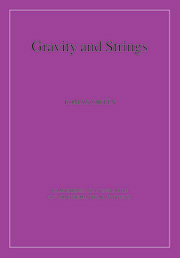Book contents
- Frontmatter
- Contents
- Preface
- Part I Introduction to gravity and supergravity
- 1 Differential geometry
- 2 Noether's theorems
- 3 A perturbative introduction to general relativity
- 4 Action principles for gravity
- 5 N = 1, 2, d = 4 supergravities
- 6 Conserved charges in general relativity
- Part II Gravitating point-particles
- Part III Gravitating extended objects of string theory
- Appendix A Lie groups, symmetric spaces, and Yang–Mills fields
- Appendix B Gamma matrices and spinors
- Appendix C n-Spheres
- Appendix D Palatini's identity
- Appendix E Conformal rescalings
- Appendix F Connections and curvature components
- Appendix G The harmonic operator on ℝ3 × S1
- References
- Index
4 - Action principles for gravity
Published online by Cambridge University Press: 20 February 2010
- Frontmatter
- Contents
- Preface
- Part I Introduction to gravity and supergravity
- 1 Differential geometry
- 2 Noether's theorems
- 3 A perturbative introduction to general relativity
- 4 Action principles for gravity
- 5 N = 1, 2, d = 4 supergravities
- 6 Conserved charges in general relativity
- Part II Gravitating point-particles
- Part III Gravitating extended objects of string theory
- Appendix A Lie groups, symmetric spaces, and Yang–Mills fields
- Appendix B Gamma matrices and spinors
- Appendix C n-Spheres
- Appendix D Palatini's identity
- Appendix E Conformal rescalings
- Appendix F Connections and curvature components
- Appendix G The harmonic operator on ℝ3 × S1
- References
- Index
Summary
A minimal action principle is a basic ingredient of any field theory. With it (with an action) we can systematically find conserved currents and charges, canonically conjugate momenta, and a Hamiltonian (which is necessary for canonical quantization), etc. On the other hand, it is easier to deal with actions than with equations of motion; it is easier to include new fields and couplings in the action respecting certain symmetries than to invent new consistent equations of motion for them and modifications of the equations of motion of the old fields.
In this chapter we are going to study in detail several action principles for GR and for more general theories we will be concerned with later on. First, we will study the standard second-order Einstein–Hilbert action that we found as the result of imposing self-consistency on the Fierz–Pauli theory coupled to matter. We will derive the Einstein equations from it and we will find the right boundary term that will allow us to impose boundary conditions on the variations of the metric δgμν only, not on its derivatives. We will do the same for theories including a scalar and in a conformal frame that is not Einstein's. In these theories, an extra scalar factor K (which could be e–2φ in the string effective action) appears multiplying the Ricci scalar and obtaining the gravitational equations becomes more involved.
We are also going to study the behavior of the Einstein–Hilbert action under GCTs and we will obtain the Bianchi (gauge) identity and Noether current associated with them and see how they are modified by the addition of boundary terms to the action.
- Type
- Chapter
- Information
- Gravity and Strings , pp. 114 - 149Publisher: Cambridge University PressPrint publication year: 2004

